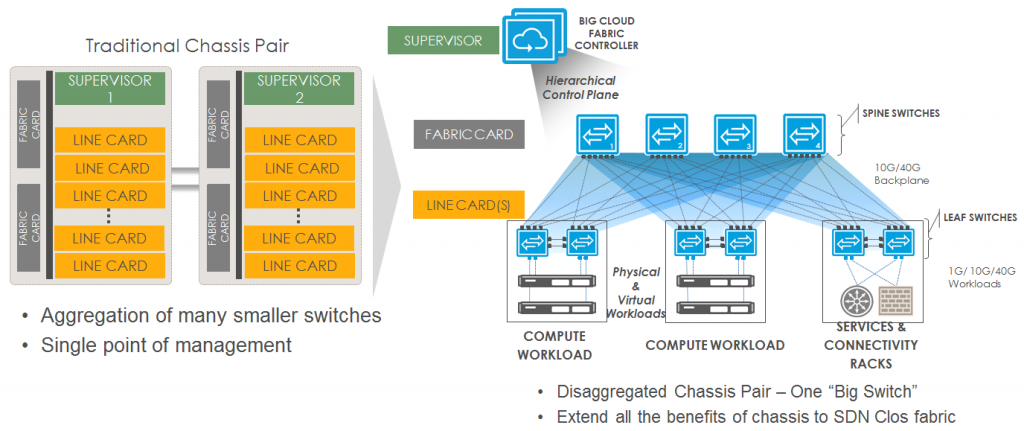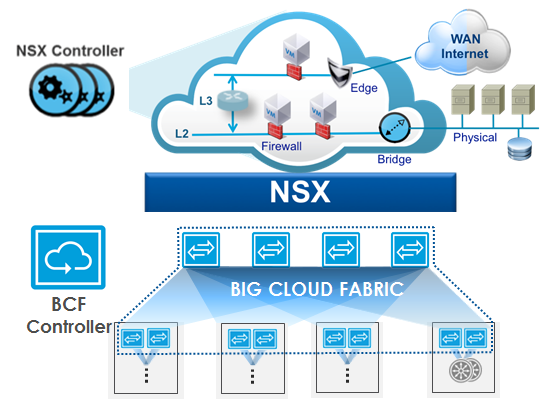This post is also available in: Italian
Reading Time: 5 minutesI’ve already talk about Big Switch in some previous posts (see Big Switch Networks has a big announce), now there are other news both in the Big Cloud Fabric (with new version 2.6) and Big Tap Monitoring Fabric (with the new versione 4.5).
The Big Tap product does not need too much explanation: it’s a 1G/10G/40G network visibility fabric that leverages high-performance bare metal Ethernet switches or Dell Open Networking switches to provide pervasive and scalable monitoring of an organization’s network traffic. The new version will add some new features and will support new switches (like the Dell S4048-ON). If you need deep network monitoring and visibility this could be an interesting solution.
But much interesting, from my point of view, is the Big Cloud Fabric (BCF) 2.6 that provides a SDN underlay on Dell Open Networking or bare-metal switches, with full visibility and integration with VMware NSX.
But let’s start from the general architecture of BCF: it’s an Hyperscale Networking where a traditional centralized chassis (composed by a supervisor, some fabric cards and some line cards) become a control plane (the big cloud controllers, that acts as the switch supervisor) and a leaf-spine based fabric (where the spines are like the fabric cards and the leafs are similar to the line cards).
The leaf-spine architecture isn’t new at all and become more standard for scalable network architecture (usually each couple of leaf are the “traditional” Top of Rack). It’s not only a new model compared to the core-distribution-access one, but something more reliable and better designed for SDN or new architecture. More important this type of architecture could be completly spanning tree free avoiding common issues in network stability and convergency.
Note that a leaf-spine network can be build also without BigSwitch (or other products), but in this case it’s simple a layer 3 network useful, for example, as a platform for some kinf of network virtualization overlay, like VMware NSX.
But with Big Cloud Fabric you can build a “single logical” switch and provide several services included distribuited switching and routing and the ability to automatically build layer 2 network on the top of it.
 Also the BCF Controller Integration with vCenter permit to:
Also the BCF Controller Integration with vCenter permit to:
- Auto Host Detection & LAG Formation
- Auto L2 Network Creation & VM Learning
- Network policy migration for vMotion/DRS
- VM Visibility and Troubleshooting
BCF’s granular multi-switch path tracing is extremely difficult to achieve for legacy box-by-box networking architectures where administrators must spend hours to manually “hop-and-hunt” with a switch-by-switch strategy in order to identify a root cause. Additionally, BCF introduces an enhanced Fabric Analytics module in the 2.6 release to support deep visibility of VMware VMs for network administrators, including VM & host properties, VM mobility events and host connectivity to the BCF leaf switches. Having a consistent view of virtualization environments across both virtualization and network admins allow rapid resolution of cross-domain issues.
But this is not the only integration with VMware: with BCF 2.6 there is also NSX-v support and visibility. But why using both? Aren’t both SDN solutions?
VMware NSX-v (for vSphere environments) constructs a vSwitch-based SDN overlay and requires an IP-based physical network to provide network virtualization and micro-segmentation. While box-by-box networking is an option for the physical underlay, it remains highly suboptimal, with manual CLI-driven operational complexities and challenging workflows for underlay visibility/troubleshooting. Big Cloud Fabric, being an SDN underlay, provides the most optimal architecture for NSX-v SDN overlay.
So they simple works at diffent “layers” and can become complementary and not competitors (although there are some overlaps in some functions): NSX will provide the SDN Overlay (one logical and central managed virtual switch) and BFC will provide the SDN Underlay (one logical and central managed physical switch).
Specifically, Big Cloud Fabric 2.6 extends support for VMware NSX-v network virtualization overlay by providing:
- Complete NSX VM and host (Virtual Tunnel End Point or VTEP) visibility in the BCF controller
- BCF Fabric Analytics extended for NSX-v VMs
- Rapid VTEP-to-VTEP trouble-shooting on BCF fabric underlay across the fabric, including source VTEP, source Leaf, spine, destination leaf, destination VTEP
Customers can benefit from operational simplicity and commodity economics of the Big Cloud Fabric SDN underlay while closing the visibility gap with NSX-v overlay and traditional physical switch deployments.
For more information see also:






